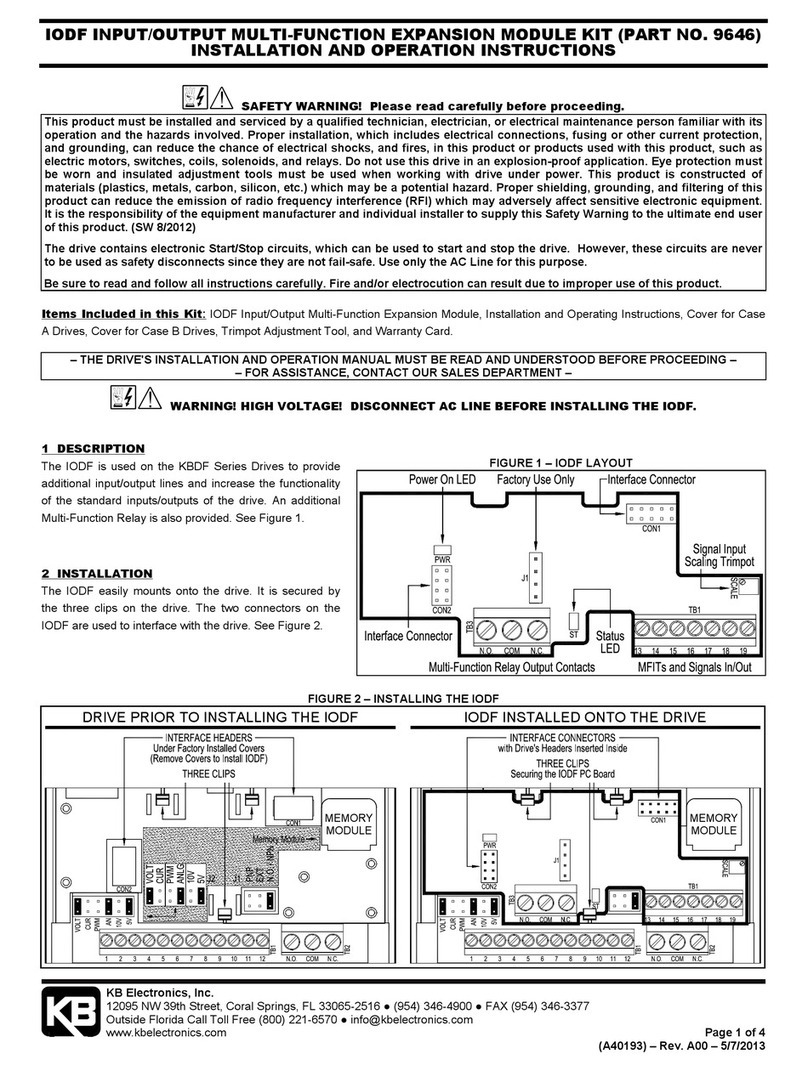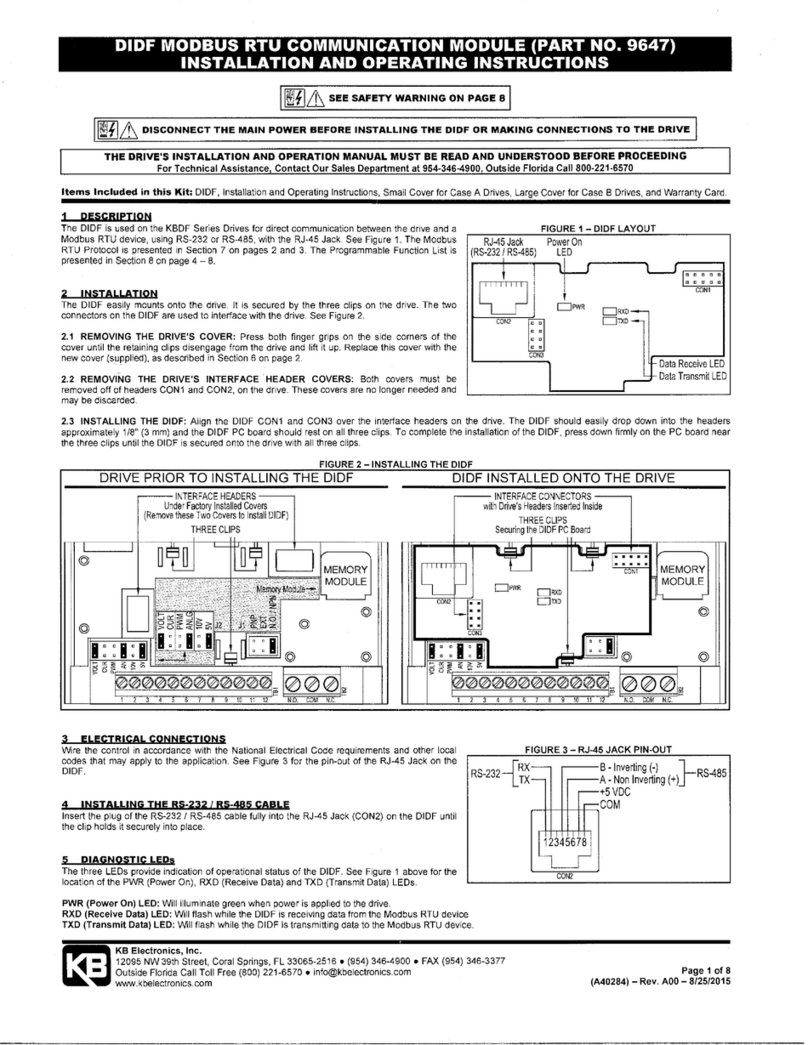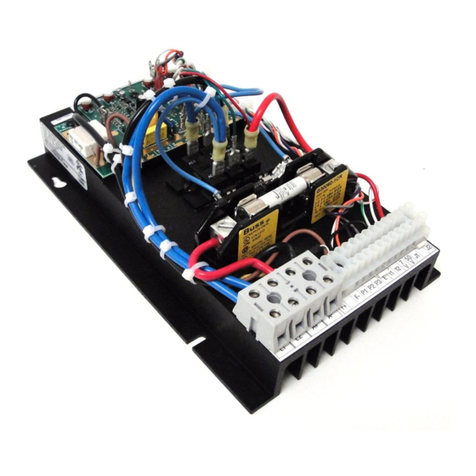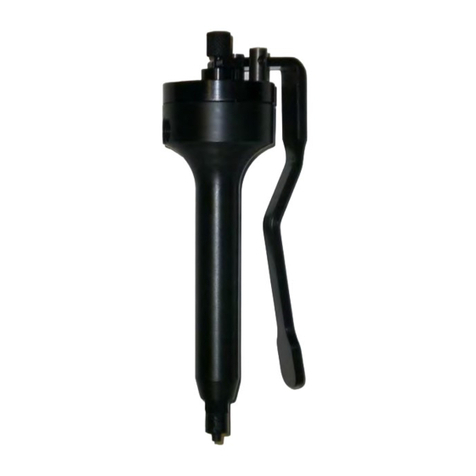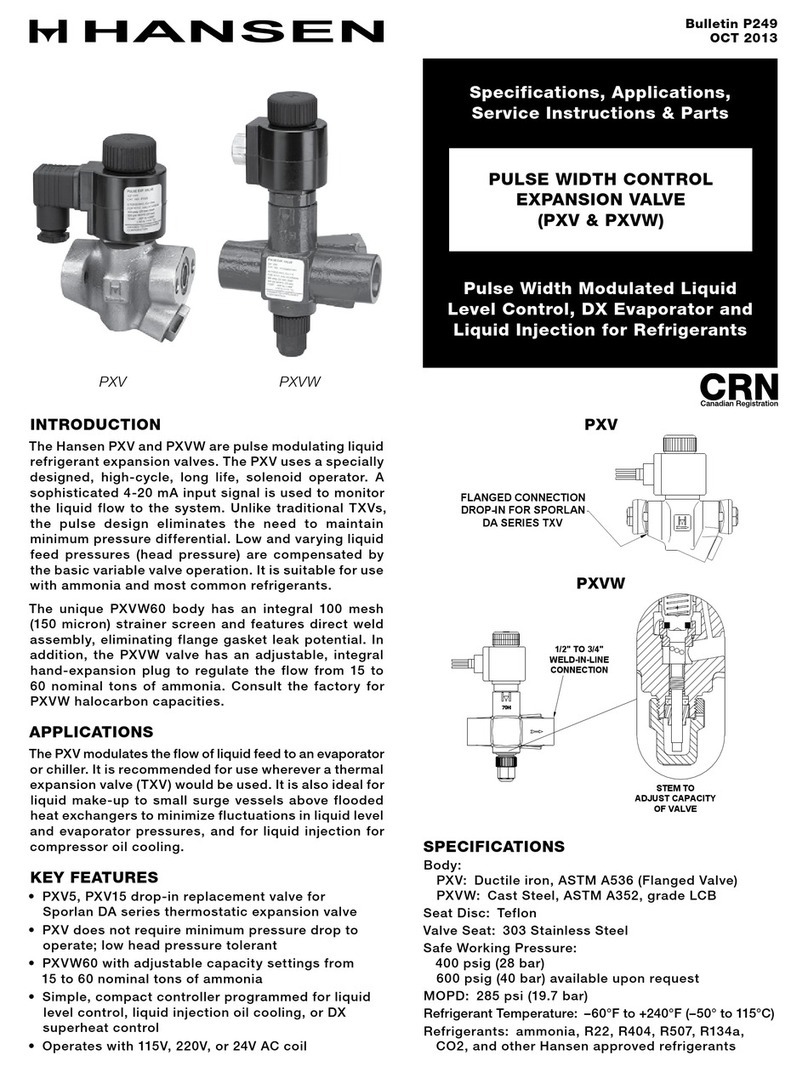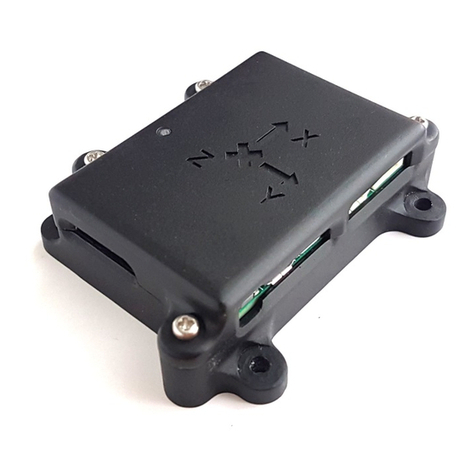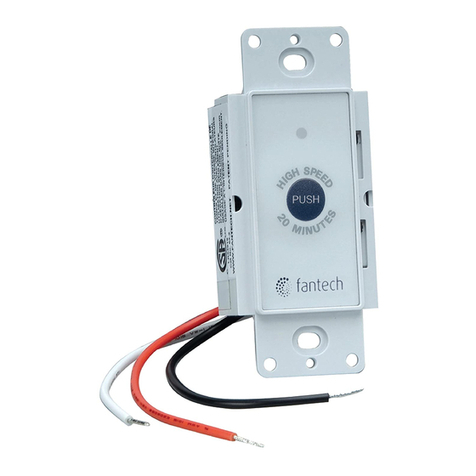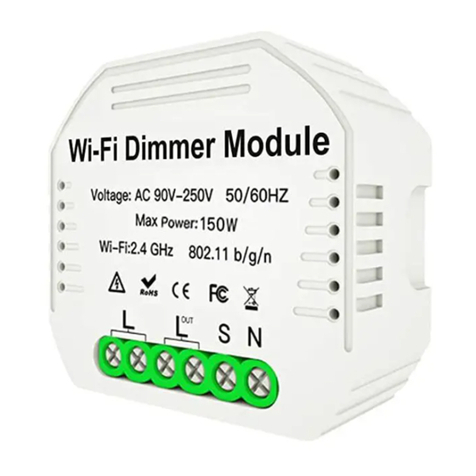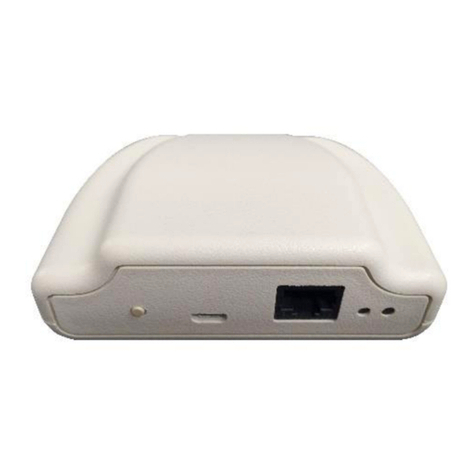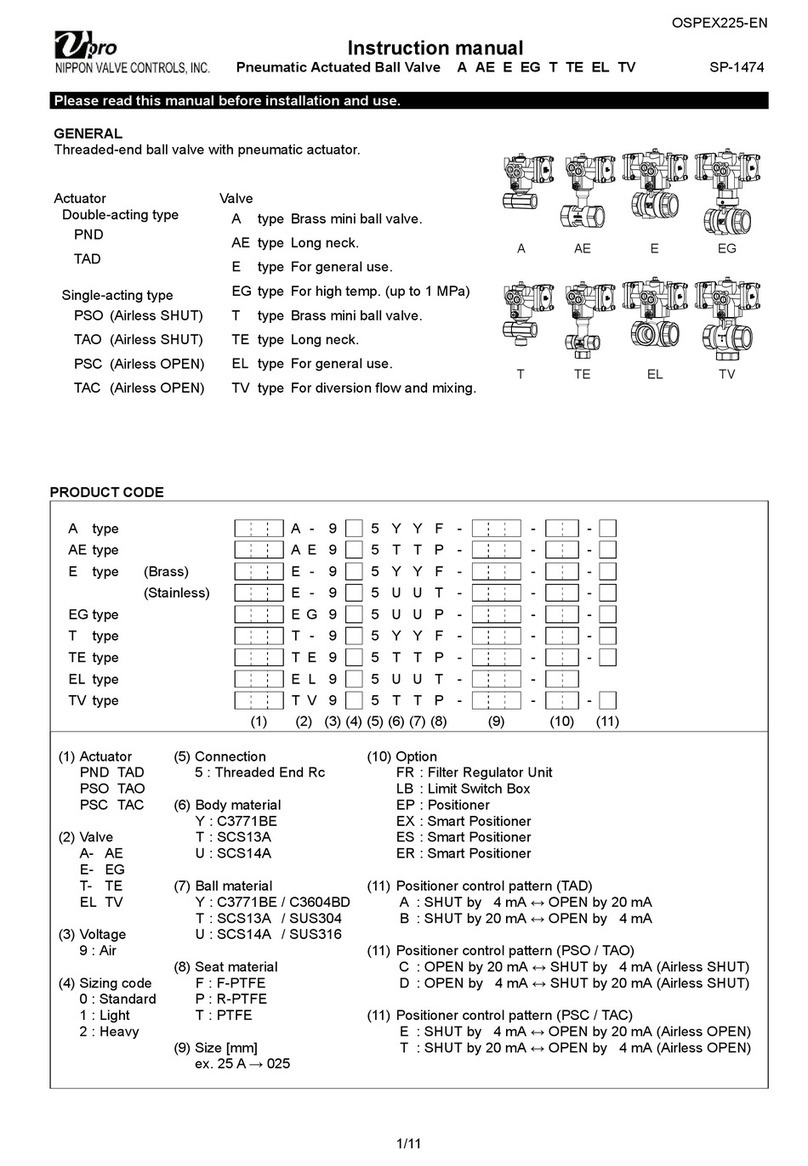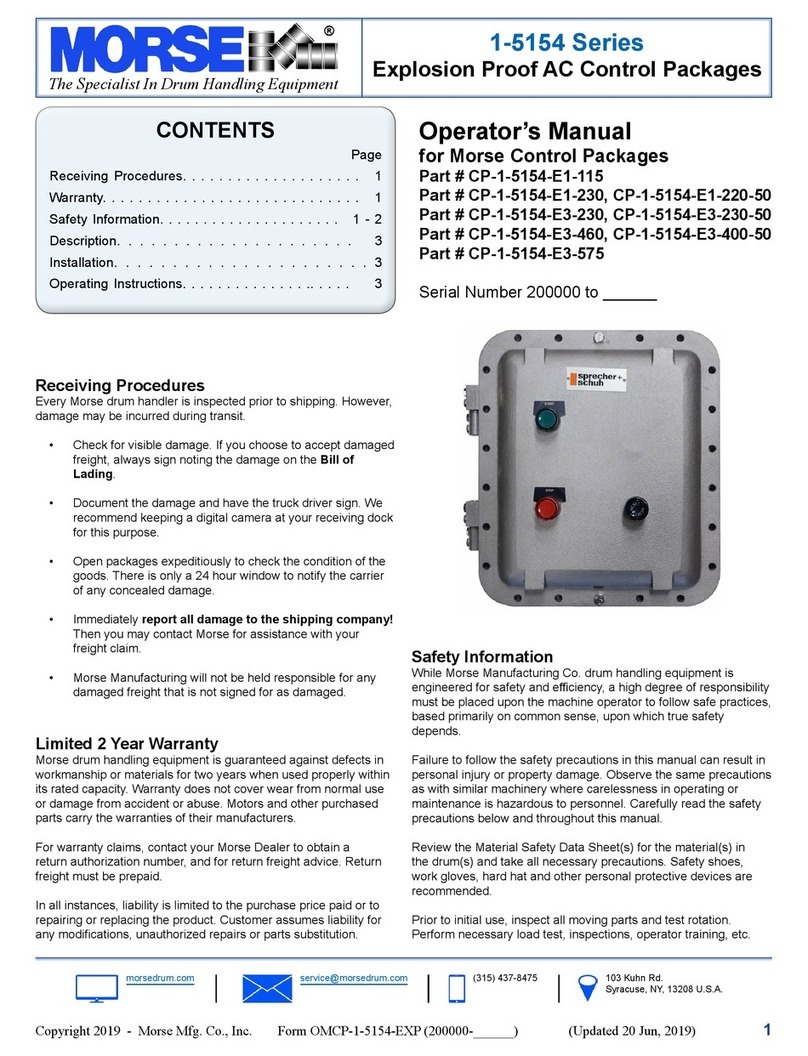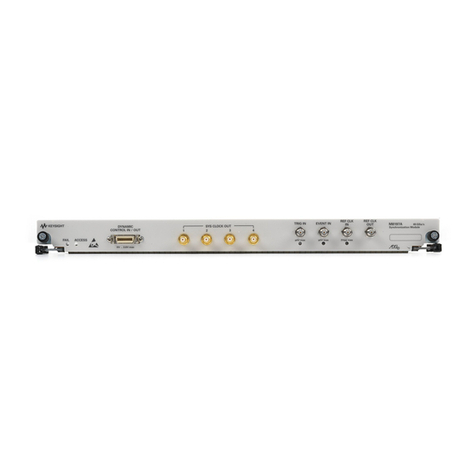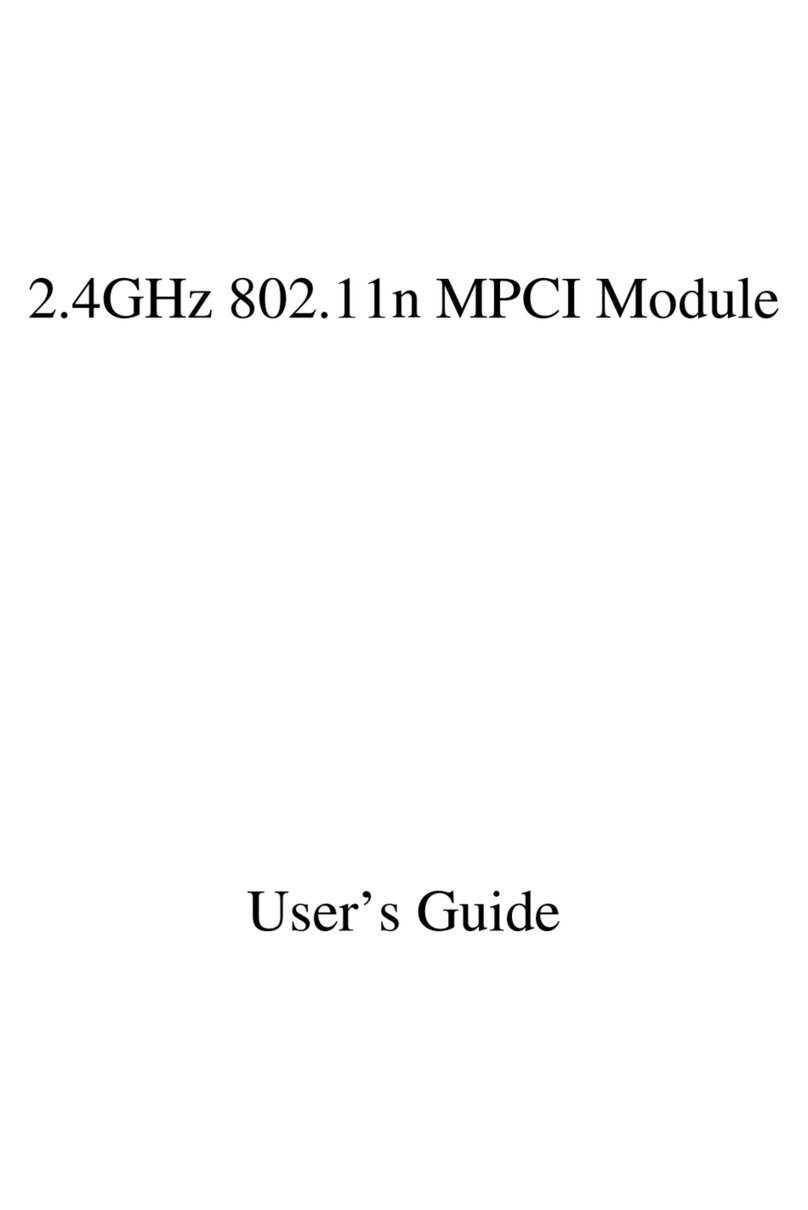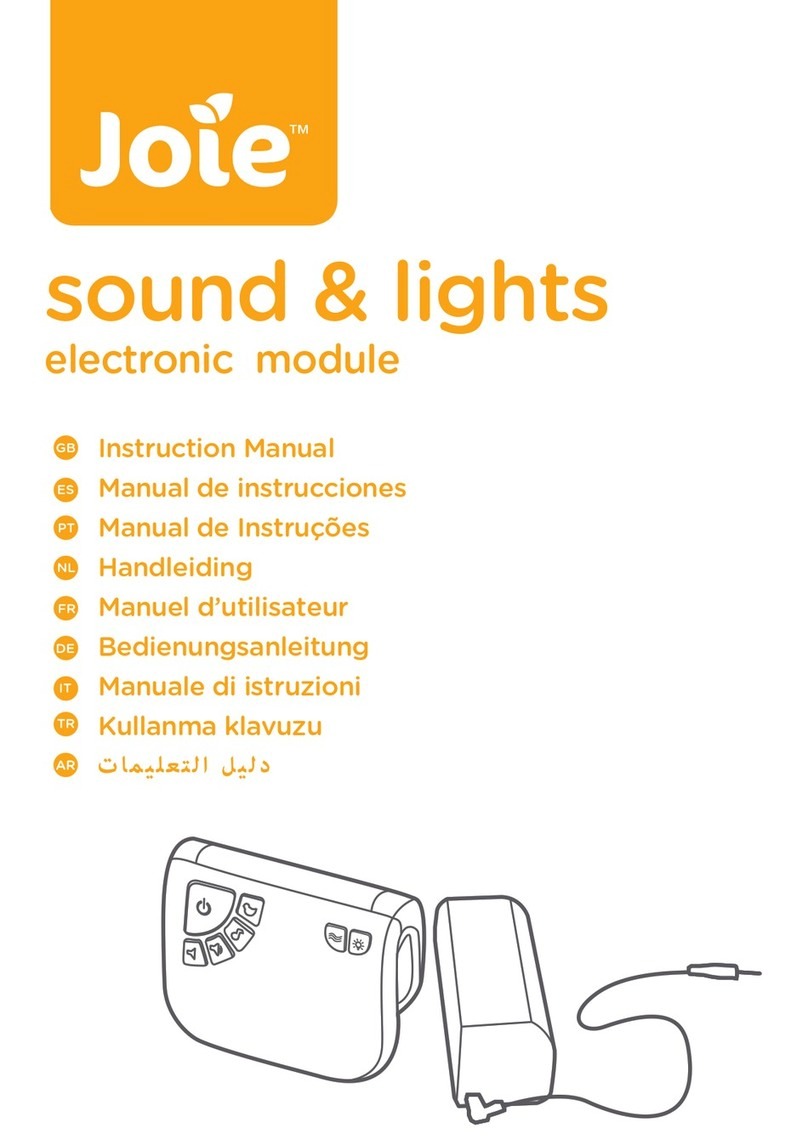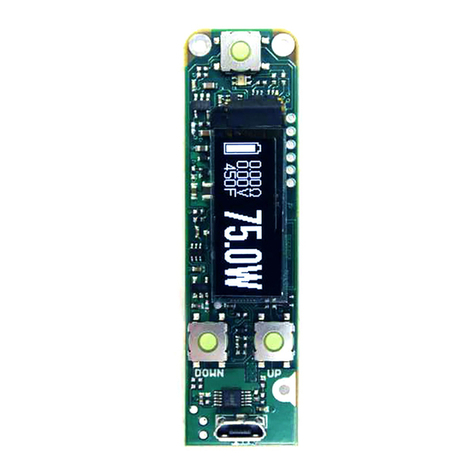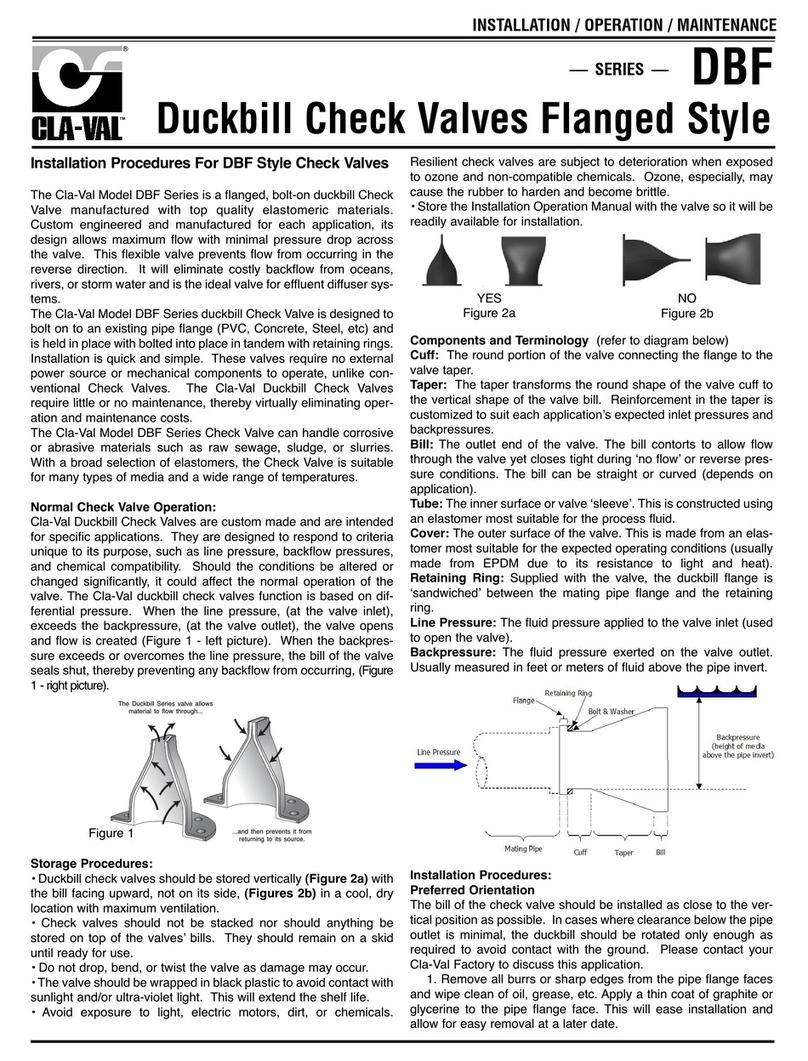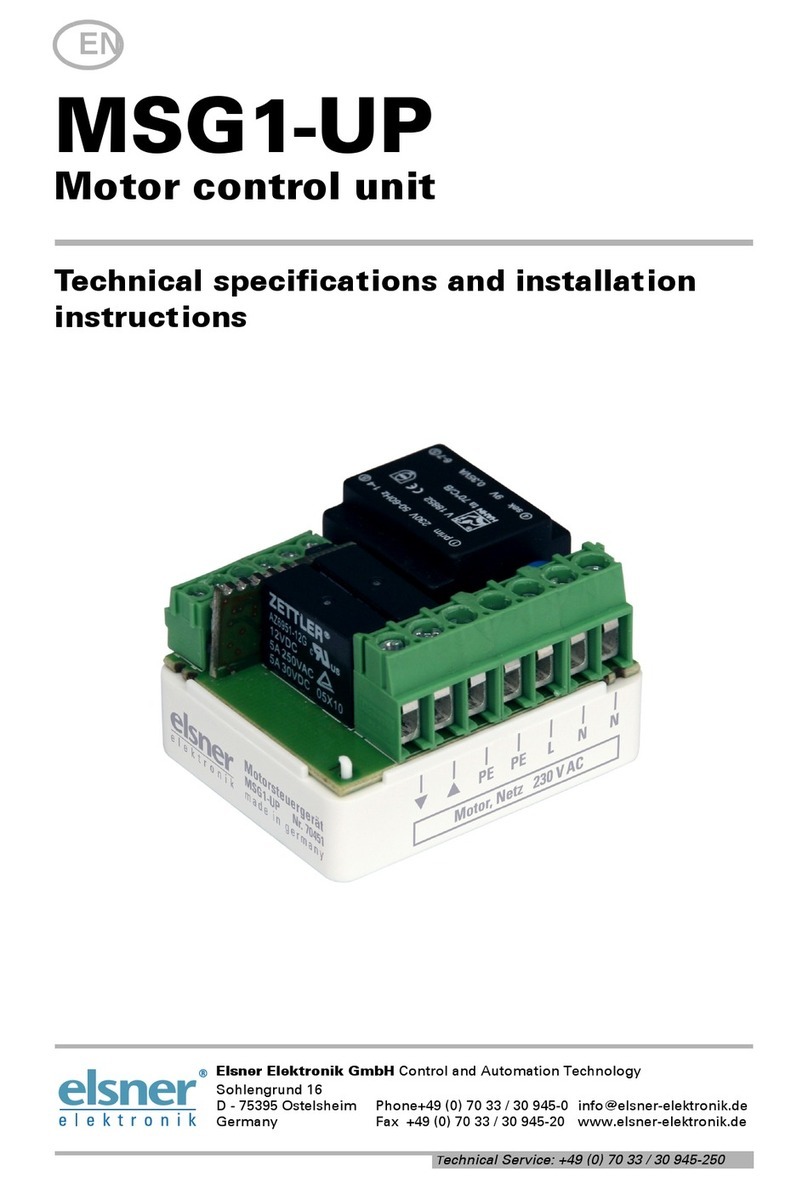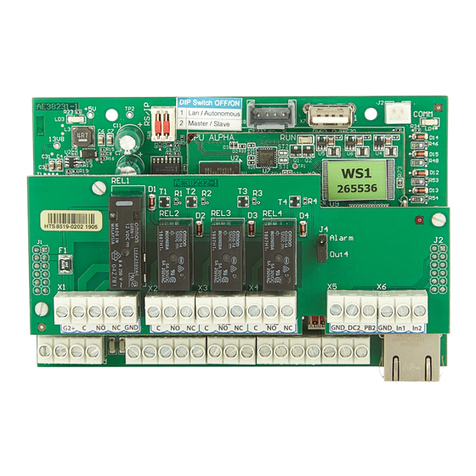KB Electronics KBPW-240D User manual

.%3:',QVWDOODWLRQDQG2SHUDWLRQ0DQXDO5HY$
6XSSOHPHQWDO,QIRUPDWLRQ
&KDQJHVWR:LULQJ6HFWLRQ,,,*RQ3DJH
G. Remote Start/Stop Switch Connections
The control is supplied with a prewired Start/Stop Switch with a normally open "NO"
stop contact. Jumper J6 is factory set to the "NO" position.
For remote 3-wire Start/Stop Switch with a normally closed "NC" stop contact, connect
the switch as shown in Figure 7A, below. Set Jumper J6 to the "NC" position.
Figure 7A
Remote 3-Wire Start/Stop Switch
with Normally Closed Stop Contact
START
STOP
&KDQJHVWR:LULQJ6HFWLRQ,,,.RQ3DJH
K. Enable Connection
Wire the Enable contact to Terminals "EN1" and "EN2" of Terminal Block TB3 as
shown in Figure 10A, below.
The Enable is used to electronically start and stop the control. When the Enable
contact is closed, the control will accelerate to the Main Speed Potentiometer setting.
When the Enable contact is opened, the control will coast to stop.
Note: The contact must be isolated from the AC line and Jumper J7 must be removed.
Figure 10A
Enable Switch Connection
WARNING! Disconnect main power when making connections to the drive.
The following information and instructions are to be used as a supplement to the
KBPW-240D Installation and Operation Manual Rev. A (Part No. A40360). The manual
must be read and understood before attempting to operate this control.
The PC board has been upgraded to include provision for normally open or normally
closed stop contacts and to connect an Enable switch. The General Performance
Specifications have not changed.
Jumper J6 (Stop Switch type "NO" or "NC" Selection) and Jumper J7 (Enable
Selection) have been added. Enable terminals have been added to Terminal Block
TB3. Also, Figures 7A and 10A have been added.
&KDQJHVWR7DEOHRI&RQWHQWVRQ3DJHLL
Figure
Page
7A Remote 3-Wire Start/Stop Switch with Normally Closed Stop Contact ..................8
10A Enable Switch Connection.....................................................................................9
ENABLE SWITCH
Page 1 of 2 Page 2 of 2
KB Electronics, Inc.
(A42140) - Rev. A00 - 3/22/2005 - Z3570A00

INSTALLATION AND OPERATING INSTRUCTIONS
MODEL KBPW-240D
KB Part No. 8401 (Black Case) • Part No. 8402 (White Case)
NEMA 4X, IP-65
PWM DC Motor Spee Control For PM an Shunt Woun Motors
Rate 7.5 Amps DC, 11.5 Amps AC @ 115/230 VAC
See Safet Warning on Page 2
The information containe in this manual is inten e to be accurate. However, the manufacturer retains
the right to make changes in esign which may not be inclu e herein.
BRK
REV
FWD
%100
90
80
70
60
50
40
30
20
10
0
NEMA-4X / IP-65
START
STOP
RUN
JOG
PWM DC MOTOR SPEED CONTROL
PENTA-DRIVE™
OLSTOPON
™
!
™
A COMPLETE LINE OF MOTOR DRIVES
© 2000 KB Electronics, Inc.
Pending

TABLE OF CONTENTS
Section Page
i. Safety Warning . . . . . . . . . . . . . . . . . . . . . . . . . . . . . . . . . . . . . . . . . . . . . . . . . . . . . . . 1
I. Intro uction . . . . . . . . . . . . . . . . . . . . . . . . . . . . . . . . . . . . . . . . . . . . . . . . . . . . . . . . . . 1
II. Simplifie Operating Instructions . . . . . . . . . . . . . . . . . . . . . . . . . . . . . . . . . . . . . . . . . . 2
III. Wiring Instructions . . . . . . . . . . . . . . . . . . . . . . . . . . . . . . . . . . . . . . . . . . . . . . . . . . . . . 6
IV. Setting Selectable Jumpers . . . . . . . . . . . . . . . . . . . . . . . . . . . . . . . . . . . . . . . . . . . . . . 9
V. Mounting Instructions . . . . . . . . . . . . . . . . . . . . . . . . . . . . . . . . . . . . . . . . . . . . . . . . . . 11
VI. Operation . . . . . . . . . . . . . . . . . . . . . . . . . . . . . . . . . . . . . . . . . . . . . . . . . . . . . . . . . . . 12
VII. AC Line Fusing . . . . . . . . . . . . . . . . . . . . . . . . . . . . . . . . . . . . . . . . . . . . . . . . . . . . . . 12
VIII. Trimpot A justments . . . . . . . . . . . . . . . . . . . . . . . . . . . . . . . . . . . . . . . . . . . . . . . . . . . 12
IX. Diagnostic LEDs . . . . . . . . . . . . . . . . . . . . . . . . . . . . . . . . . . . . . . . . . . . . . . . . . . . . . 13
X. Optional Accessories . . . . . . . . . . . . . . . . . . . . . . . . . . . . . . . . . . . . . . . . . . . . . . . . . . .14
XI. Limite Warranty . . . . . . . . . . . . . . . . . . . . . . . . . . . . . . . . . . . . . . . . . . . . . . . . . . . . . 18
Tables
1. Electrical Ratings . . . . . . . . . . . . . . . . . . . . . . . . . . . . . . . . . . . . . . . . . . . . . . . . . . . . . .3
2. General Performance Specifications . . . . . . . . . . . . . . . . . . . . . . . . . . . . . . . . . . . . . . . . 3
3. Terminal Block Wiring Information . . . . . . . . . . . . . . . . . . . . . . . . . . . . . . . . . . . . . . . . . 6
4. Fiel Connection (Shunt Woun Motors Only) . . . . . . . . . . . . . . . . . . . . . . . . . . . . . . . . 7
5. Setting Motor Current (SCR & PWM Motor Horsepower Ratings) . . . . . . . . . . . . . . . . . 10
Figures
1. Control Layout . . . . . . . . . . . . . . . . . . . . . . . . . . . . . . . . . . . . . . . . . . . . . . . . . . . . . . . .4
2. Mechanical Specifications . . . . . . . . . . . . . . . . . . . . . . . . . . . . . . . . . . . . . . . . . . . . . . . .5
3. Power Connection . . . . . . . . . . . . . . . . . . . . . . . . . . . . . . . . . . . . . . . . . . . . . . . . . . . . . 6
4. Full Voltage Fiel . . . . . . . . . . . . . . . . . . . . . . . . . . . . . . . . . . . . . . . . . . . . . . . . . . . . . .7
5. Half Voltage Fiel . . . . . . . . . . . . . . . . . . . . . . . . . . . . . . . . . . . . . . . . . . . . . . . . . . . . . .7
6. Remote Potentiometer . . . . . . . . . . . . . . . . . . . . . . . . . . . . . . . . . . . . . . . . . . . . . . . . . . 7
7. Remote Start/Stop Switch . . . . . . . . . . . . . . . . . . . . . . . . . . . . . . . . . . . . . . . . . . . . . . . 8
8. Voltage Following . . . . . . . . . . . . . . . . . . . . . . . . . . . . . . . . . . . . . . . . . . . . . . . . . . . . . . 8
9. Inhibit Circuit . . . . . . . . . . . . . . . . . . . . . . . . . . . . . . . . . . . . . . . . . . . . . . . . . . . . . . . . . 8
10. Enable Circuit . . . . . . . . . . . . . . . . . . . . . . . . . . . . . . . . . . . . . . . . . . . . . . . . . . . . . . . . 9
11. DC Tach-Generator . . . . . . . . . . . . . . . . . . . . . . . . . . . . . . . . . . . . . . . . . . . . . . . . . . . . 9
12. Motor Voltage Selection . . . . . . . . . . . . . . . . . . . . . . . . . . . . . . . . . . . . . . . . . . . . . . . . . 9
13. Motor Current Selection . . . . . . . . . . . . . . . . . . . . . . . . . . . . . . . . . . . . . . . . . . . . . . . . . 9
14. Removing Resistor R35 (for low current selection) . . . . . . . . . . . . . . . . . . . . . . . . . . . . 10
15. Current Limit Mo e Selection . . . . . . . . . . . . . . . . . . . . . . . . . . . . . . . . . . . . . . . . . . . . 10
16. DC Tach-Generator Voltage Selection . . . . . . . . . . . . . . . . . . . . . . . . . . . . . . . . . . . . . . 11
17. DC Tach-Generator with A ition of RT . . . . . . . . . . . . . . . . . . . . . . . . . . . . . . . . . . . . . 11
18. Run Relay Output Mo e Selection . . . . . . . . . . . . . . . . . . . . . . . . . . . . . . . . . . . . . . . . 12
ii

I. INTRODUCTION
Thank you for purchasing the KBPW-240D. KB Electronics, Inc. is committe to provi ing
total customer satisfaction by pro ucing quality pro ucts that are easy to install an operate.
The KBPW-240D is manufacture with surface mount components incorporating a vance
circuitry an technology.
The KBPW-240D is a Pulse Wi th Mo ulate (PWM) control in a NEMA-4X / IP-65 watertight
an wash own enclosure esigne to operate PWM an SCR rate Permanent Magnet an
Shunt Woun motors ranging from 0.2 Amps DC to 7.5 Amps DC. It operates at a switching
frequency greater than 16kHz to provi e high motor efficiency an quiet operation. Special
circuitr automaticall accepts AC line input voltages of 115 Volts AC to 208/230 Volts
AC (±10%, 50/60Hz) without having to make a jumper selection.
Stan ar panel mounte features inclu e iagnostic LEDs (power on, stop, an overloa ),
Start/Stop switch, an spee potentiometer. Other features inclu e barrier terminal blocks
(facilitate wiring of AC line, motor armature, motor fiel , tach-generator an run relay con-
nections), a justable trimpots (acceleration, eceleration, maximum spee , minimum spee ,
jog spee [use with optional Run/Jog switch], current limit, time current limit an IR Comp.)
1
i. SAFETY WARNING! Please read carefull
This pro uct shoul be installe an service by a qualifie technician, electrician, or elec-
trical maintenance person familiar with its operation an the hazar s involve . Proper instal-
lation, which inclu es wiring, mounting in proper enclosure, fusing or other overcurrent pro-
tection, an groun ing can re uce the chance of electrical shocks, fires, or explosion in this
pro uct or pro ucts use with this pro uct, such as electric motors, switches, coils, solenoi s,
an /or relays. Eye protection must be worn an insulate a justment tools must be use
when working with control un er power. This pro uct is constructe of materials (plastics,
metals, carbon, silicon, etc.) which may be a potential hazar . Proper shiel ing, groun ing,
an filtering of this pro uct can re uce the emission of ra io frequency interference (RFI)
which may a versely affect sensitive electronic equipment. If further information is require
on this pro uct, contact the factory. It is the responsibility of the equipment manufacturer an
in ivi ual installer to supply this Safety Warning to the ultimate en user of this pro uct. (SW
effective 11/1992.)
This control contains electronic Start/Stop circuits that can be use to start an stop the
control. However these circuits are never to be use as safety isconnects since they are not
fail-safe. Use only the AC line for this purpose.
Be sure to follow all instructions carefully. Fire an /or electrocution can result ue to
improper use of this pro uct.
!
PWM Safet Warning! This control contains a safet circuit which is designed to
prevent full speed runawa in the event the main power transistor fails. However,
this safet circuit is not infallible and ma itself fail to operate and therefore allow a full
speed runawa condition to exist. The installer of this product should take proper pre-
cautions to include other means to protect the operator or the machine involved (such
as mechanical disconnects, warning notices, etc.).
!
This pro uct complies with all CE irectives pertinent at the time of manufacture.
Contact factory for etaile installation an Declaration of Conformity. Installation of
a CE approve RFI filter (KBRF-200A [P/N 9945C] or equivalent) is require . A itional
shiel e motor cable an /or AC line cables may be require along with a signal isolator (KBSI-
240D [P/N 9431] or equivalent).

Optional accessories inclu e On/Off AC Line Switch, FWD-BRK-REV Switch, Run-Stop-Jog
Switch, Signal Isolator, an Anti-Plug Reversing Mo ule. Quick-connect terminals are pro-
vi e for easy installation of all optional accessories. The control is available in black finish
(P/N 8401) an FDA approve white finish (P/N 8402).
STANDARD FEATURES
•Short Circuit Protection – Protects control from a short circuit at motor connections.
•Electronic Motor Burnout Protection – Shuts own the control if a prolonge overloa con-
ition exists.
•Active Bridge – Limits the AC line inrush current when power is turne on an also prevents
high spee runaway if the power transistor shorts.
•Heat Spreader – Allows power transistor to operate safely uring momentary overloa con-
itions.
•Auto AC Line Select – Control automatically a justs for 115 or 208/230 Volt AC line input.
•Start/Stop Switch – Provi es electronic start an stop functions.
•Diagnostic LEDs – For power on (ON), stop (STOP) an motor overloa (OL).
•Trimpots – Provi e a justment for acceleration (ACCEL), eceleration (DECEL), maximum
spee (MAX), minimum spee (MIN), jog spee (JOG), current limit (CL), time current limit
(TCL), an IR compensation (IR).
•Selectable Jumpers – Provi e settings for armature voltage or tach-generator fee back
(J1), motor current (J2), time or non-time current limit (J3), tach-generator voltage (J4), an
run relay output (J5).
•Barrier Terminal Blocks – Facilitate wiring of AC line, motor armature an fiel , tach-gen-
erator, an run relay output.
•Quick-Connect Terminals – Facilitate connecting Start/Stop switch, Run-Stop-Jog switch,
FWD-BRK-REV switch, an Inhibit switch.
II. SIMPLIFIED OPERATING INSTRUCTIONS
A. Power Connection – Connect the AC line to L1 an L2 terminals of TB1 an the groun
wire (Earth) to the green groun screw as shown in Figure 3, on page 6 an as escribe
in Section IIIA, on page 6 an Section IIIB, on page 6.
B. Permanent Magnet (PM) Motor Connection (Two-Wire T pe) – Connect the motor
armature to A1 (+) an A2 (-) terminals of TB1 as shown in Figure 3, on page 6 an as
escribe in Section IIIC, on page 6. Be sure that jumper J3 is set to the correspon ing
motor voltage position as escribe in Section IVA, on page 9. Do not use F1 and F2
terminals of TB2 for an purpose other than to power the field of a shunt wound
motor. Do not use F1 and F2 terminals for PM motors.
Note: Motor performance an efficiency, inclu ing brush life, may be a versely affecte
when operating the control in step own mo e (208/230 Volt AC line with 90/130 Volt DC
motors).
C. Shunt Wound Motors (Four-Wire T pe) – Connect the motor armature as escribe in
Section IIIC, on page 6. Connect full voltage fiel wires (90 Volt DC motors with 100 Volt
DC fiel an 180 Volt DC motors with 200 Volt DC fiel ) to F1 (+) an F2 (-) terminals of
TB2 as escribe in Section IIID, on page 7. Connect half voltage fiel wires (90 Volt DC
motors with 50 Volt DC fiel an 180 Volt DC motors with 100 Volt DC fiel ) to F1 (+) ter-
minal of TB2 an L1 (-) terminal of TB1 as escribe in Section IIIE, on page 7.
Note: Do not connect motor armature lea s to F1 an F2 terminals.
2
IMPORTANT – You must rea these simplifie operating instructions before procee ing.
These instructions are to be use as a reference only an are not inten e to replace the
etaile instructions provi e herein. You must rea the Safety Warning, on page 1,
before procee ing.

D. Motor Current – Jumper J2 is factory set for 7.5 Amp motors. For lower current motors,
set jumper J2 to the correspon ing motor current as escribe in Section IVB, on page 9.
Note: The factory setting for Current Limit is 150% of the nominal current setting (exam-
ple: if jumper J2 is set to “5A” position, the CL trimpot is calibrate for 7.5 Amps).
E. Trimpot Settings – All trimpots have been factory set as shown in Figure 1, on page 4.
Trimpots may be rea juste as escribe in Section VIII, on page 12.
F. Diagnostic LEDs – After power has been applie , observe the LEDs to verify proper con-
trol function as escribe in Section IX, on page 13.
G. Start/Stop Switch – The control is supplie with a prewire Start/Stop switch as
escribe in Section IIIG, on page 8. This switch must be use to start the control each
time the AC power is lost or the control shuts own in TCL. To overri e this function, see
Section IIIG, on page 8.
1. For low current operation, remove resistor R35 as escribe in section IVB, on page 9
2. Step- own operation – Motor may have re uce brush life – Consult motor manufacturer.
3
115
AC Line Voltage
(±10%, 50/60 Hz)
(Volts AC)
Motor Voltage
(Volts DC)
Maximum AC
Line Current
(Amps RMS)
Maximum
Load Current
(Amps DC)
Maximum Horsepower
HP, (kW)
SCR Rated
Motors
PWM Rated
Motors
3/4, (0.5)
208 – 230
0 – 90, 130 11.5 7.5 1, (0.75)
Field Voltage
(Volts DC)
200
100
7.5 2, (1.5)11⁄2, (1)11.50 – 180, 260
TABLE 1 – ELECTRICAL RATINGS
0
100
Specification Factor SettingParameter
0 – 50
Operating Frequency (kHz)
0.5 – 10
Operating Temperature Range at Full Rating (ºC)
>16 –
Current Range (High Scale) (Amps DC)
0 – 50 –
1.7, 2.5, 3.5, 5.0, 7.5 7.5
Current Range (Low Scale) (Amps DC)1
ACCEL an DECEL Range (Secon s)
Jog Spee (% Base Spee )
MIN Spee Range (% Base Spee [90VDC & 180VDC Motors])
MAX Spee Range (% Base Spee [90VDC & 180VDC Motors])
IR Comp Range at 90 Volts DC Output (∆Volts DC at Full Loa )
IR Comp Range at 180 Volts DC Output (∆Volts DC at Full Loa )
CL Range (% Range Setting)
Time Current Limit (TCL) Range (Secon s)
AC Line Input Voltage (Volts AC, ±10%, 50/60 Hz)
Armature Voltage Range at 115 Volts AC Line Input (Volts DC)
Armature Voltage Range at 208/230 Volts AC Line Input (Volts DC)
Fiel Voltage at 115 Volts AC Line Input (Volts DC) –
–
Fiel Voltage at 208/230 Volts AC Line Input (Volts DC)
Spee Range (Ratio) 50:1
0.2, 0.3, 0.4, 0.5, 0.8
0.5 – 10
0 – 30
50 – 140
0 – 15
0 – 30
0 – 200
115 – 208/230
0 – 130
0 – 130 2, 0 – 260
100/50
200/100
150
–
1
15
4
8
5
–
90
90
–
Voltage Following Linearity (% Base Spee ) ±0.5 –
TABLE 2 – GENERAL PERFORMANCE SPECIFICATIONS
AC Line Regulation (% Base Spee ) 0.5 –
Armature Fee back Loa Regulation (% Base Spee ) 1 –
Tach-Generator Fee back Loa Regulation (% Set Spee ) 1–

CL
YRGB
STOPON
LED BOARD
VIOLET
ORANGE
START/STOP SWITCH
WHITE
MAIN SPEED
POTENTIOMETER
J6B
J6A
L2BL1BL1A L2A
J7B
J7A
0.21.7
0.5
0.8
0.4
AMPS
0.3
3.5
7.5
5.0
2.5
HL
90V 180V
T
TACH
C56
J3
C55
J1
J2
D11Q3
R35
START
INH2
INH1
STOP
COM
P2
P3
JOG
TB4
K2
P1
TB3
T-
K1
RELAY
T+
J47V 50V
T1
T2
KBPW 240D
TCL NTCL
NC NO
A57440
RED
BLACK
WHITE
J5
K1
Q4
Q5
BLK
A2A
ORG RED
TB1
A1B A1A
CON2
A2B
WHT
L2A2 L1A1
TB2
D20
D6
F2F1
BLU WHTBLU WHT
CON1
ACCEL DECEL MAX MIN JOG CL TCL IR
ACCEL DECEL MAX MIN JOG CL TCL IR
Enlarged view of trimpots
4
FIGURE 1 – CONTROL LAYOUT
(Illustrates Factory Setting of Jumpers an Approximate Trimpot Settings)

5
BRK
REV
FWD
0.357
[9.07]
8.876
[225.45]
8.226
[208.94]
5.472
[138.99]
5.886
[149.50]
%100
90
80
70
60
50
40
30
20
10
0
NEMA-4X / IP-65
START
STOP
RUN
JOG
PWM DC MOTOR SPEED CONTROL
PENTA-DRIVE™
OLSTOPON
™
5.000
[127.00]
9.488
[241.00]
CONTROL SHOWN WITH OPTIONAL FWD-BRK-REV AND RUN-STOP-JOG SWITCHES
FIGURE 2 – MECHANICAL SPECIFICATIONS (INCHES / [mm])

III. WIRING INSTRUCTIONS
Warning! Rea Safety Warning,
on page 1, before using this
control. Disconnect the AC line before
wiring.
Note: To avoi erratic operation, o not
bun le AC line an motor wires with wires
from signal following, start/stop switch,
inhibit, or any other signal wires. Use
shiel e cables on all signal wiring over
12” (30cm). Shiel shoul be Earth
groun e on the control si e only. Wire
the control in accor ance with the National
Electrical Co e requirements an other
co es that may apply to your area. See
Figure 3, Table 3 an Table 4, on page 7.
Be sure to properly fuse each con uctor that is not at groun potential. Do not fuse neutral
or grounded conductors. See Section VII, on page 12. A separate AC line switch or con-
tactor must be wire as a isconnect so that each ungroun e con uctor is opene . An
accessory On/Off AC Line Switch (P/N 9341) may be use in lieu of, or in a ition to, the
Start/Stop switch. The switch can be wire for single pole or ouble pole operation, as
require .
To maintain the watertight integrity of the control, be sure to use suitable watertight connec-
tors an wiring which are appropriate for the application. Two 7/8” (22.2mm) knockout holes
are provi e for stan ar 1/2” knockout connectors (not supplie ) for wiring. A watertight
plug is provi e if only one knockout is require .
Warning! Do not wire switches or relays in series with the armature. Armature switch-
ing can cause catastrophic failure of motor an /or control. To avoi erratic operation,
o not bun le AC line an motor wires with potentiometer wires, voltage following wires,
Start/Stop switch wires, inhibit wires, or any other signal wires. Use shiel e cables on all
signal wiring over 12” (30cm) long. Shiel shoul be Earth groun e on the control si e only.
Warning! Do not use CON2 for an purpose other than to power the optional Anti-Plug
Reversing Module APRM-PC (P/N 9378A).
A. AC Line Connection – Wire AC line input to L1 an L2 terminals of TB1 as shown in
Figure 3.
B. Ground Connection – Earth groun the control chassis using the green groun screw
that is provi e on the insi e of the control to the right si e of TB1 as shown in Figure 3.
C. Permanent Magnet (PM) Motor Connection – Wire the motor armature lea s to A1 (+)
an A2 (-) terminals of TB1 as shown in Figure 3. Be sure jumper J1 is set to the appro-
priate motor voltage an that J3 is set to the appropriate motor current. For step- own
6
!
!
AC LINE
+
M
-
MOTOR GROUND
(EARTH)
L2A2A1 L1
TB1
TB2
F2F1
FIGURE 3 – POWER CONNECTION
3.5
12
Terminal
Block
TB1
TB1
TB2
TB3
Suppl Wire Gauge
(AWG - Cu)
TB4
Designation Connections
Maximum
Tightening Torque
(in-lbs)
L1 & L2
A1 & A2
F1 & F2
T+ & T-
K1 & K2
Minimum Maximum
22
22
24
24
24
12
12
14
14
14
12
3.5
3.5
AC Line Input
Motor Armature
Motor Fiel (Shunt Woun Motors Only)
Tach-Generator
Run Relay
TABLE 3 – TERMINAL BLOCK WIRING INFORMATION

operation (230 Volt AC line input with 90
Volt DC SCR rate motor or 130 Volt DC
PWM rate motor) set jumper J1 to
“90V” position. However, in step- own
operation the motor may have re uce
brush life - consult motor manufacturer.
Note: Do not connect motor armature
lea s to F1 an F2 terminals. Do not
use F1 an F2 terminals for PM motors.
D. Full Voltage Field Connection (Shunt
Wound Motors Onl ) – Wire the motor
fiel lea s to F1 (+) an F2 (-) terminals
of TB2 as shown in Figure 4 an Table 4.
Note: Do not connect motor armature lea s to F1 an F2 terminals.
Warning! Do not use F1 and F2 termi-
nals of TB2 for an purpose other than
to power the field of a shunt wound
motor.
E. Half Voltage Field Connection (Shunt
Wound Motors Onl ) – Wire the motor
fiel lea s to F1 (+) an L1 (-) terminals
of TB2, as shown in Figure 5 an Table 4.
Note: Do not connect motor armature
lea s to F1 an F2 terminals.
Warning! Do not use F1 and F2 termi-
nals of TB2 for an purpose other than
to power the field of a shunt wound
motor.
F. Remote Main Speed Potentiometer
Connection – The control is supplie with a
prewire main spee potentiometer mounte
on the front cover. To operate the control from
a remote potentiometer (5kΩ), remove the
white, orange, an violet potentiometer lea s
from P1, P2, an P3 terminals, respectively.
The lea s may be tape an left insi e the
control. The potentiometer assembly may be
remove if a watertight seal is use to cover
the hole in the front cover. Connect the
remote main spee potentiometer wires to
terminals P1 (low si e), P2 (wiper), an P3
(high si e) as shown in Figure 6.
7
+
M
+
-
MOTOR AC LINE
-
FIELD
GROUND
(EARTH)
L2L1A1 A2
TB2
TB1
F1 F2
FIGURE 4 – FULL VOLTAGE FIELD
AC LINE
-
-
+
+
MOTOR
M
(EARTH)
FIELD
GROUND
L2L1A2A1
TB2F1 F2
TB1
FIGURE 5 – HALF VOLTAGE FIELD
Field Connections
F1 & L1
AC Line Voltage
(Volts AC)
Armature Voltage
(Volts DC)
Field Voltage
(Volts DC)
90 – 130115
115
230 180 – 260
230
230
90 – 130
180 – 260
90 – 130
100
50
200
100
100
F1 & F2
F1 & L1
F1 & F2
F1 & L1
TABLE 4 – FIELD CONNECTION (Shunt Wound Motors Onl )
(FRONT VIEW)
Wiper
Low Side
High Side
POTENTIOMETER
MAIN SPEED
TACH
P3
P2
P1
RELAY
TB4
K1
K2
T+
TB3
T-
FIGURE 6 – REMOTE POTENTIOMETER

G. Remote Start/Stop Switch Connections – The control is supplie with a prewire
Start/Stop switch mounte on the front cover. To operate the control from a remote
Start/Stop switch (type: (ON)-OFF-ON, SPDT), remove the white, black, an re wires
from START, COM, an STOP terminals,
respectively. The lea s may be tape an
left in the control. The switch itself may be
remove if a watertight seal is use to
cover the hole in the front cover. Connect
the remote Start/Stop switch wires to
START (momentary), COM (common),
an STOP (constant) terminals as shown
in Figure 7. After applying power, momen-
tarily set the Start/Stop switch to “START”
position. The motor will operate at the set
spee of the main spee potentiometer.
To stop the motor, set the Start/Stop
switch to “STOP” position.
Note: To eliminate the Start/Stop function, connect the START an COM terminals with
the jumper that is provi e .
CAUTION! Eliminating the Start/Stop function using a jumper will cause the motor to run
at the main spee potentiometer setting when the AC line is applie .
H. Run Rela Connection – Normally open (NO) or normally close (NC) relay output con-
tacts are available at TB4, which will change state when the Start/Stop switch is set to
“START” position or if the control shuts own an goes into STOP mo e from TCL. The
run relay is use to in icate the state of the control (run or stop). Normally open or nor-
mally close run relay contact outputs can be selecte epen ing on the position of
jumper J5. If normally open is selecte (J5 in “NO” position), the run relay output contacts
will close when the Start/Stop switch is set to “START” position. If normally close is
selecte (J5 set to “NC” position), the run relay output contacts will open when the
Start/Stop switch is set to “START” position. When the control shuts own an goes into
STOP mo e from TCL, or the Start/Stop switch is set to “STOP” position, the Run Relay
output contacts will return to their normal position.
Note: If relay output contacts are not require
for your application, J5 may be in any position.
I. Voltage Following Connection – An isolate
0 - 10 Volt DC analog signal can also be use
to control motor spee . See Figure 8.
Note: If an isolate signal voltage is not avail-
able, an optional signal isolator can be
installe (KBSI-240D, P/N 9431). Connect the
isolate signal voltage to P2 (+) an P1 (-) ter-
minals. A justment of the MIN trimpot may be
necessary to achieve a 0 Volt DC output.
J. Inhibit Connection – The control is supplie
with inhibit terminals (INH1 an INH2) to con-
nect an Inhibit switch. See Figure 9. These
terminals are use to electronically stop the
control. When the Inhibit switch is close ,
the control will coast to stop. When the
Inhibit switch is opene , the control will
accelerate to the main spee potentiometer
setting.
Warning! Do not use Inhibit as a
safet disconnect. Use onl the AC line for this purpose.
8
White
Re
Black
START
STOP
START/STOP SWITCH
INH1
INH2
COM
STOP
START
CON1
FIGURE 7 – REMOTE START/STOP SWITCH
(ISOLATED)
0 - 10V DC
+-
TACH
P3
TB4
P1
K2
K1
TB3
RELAY
T+
T-
P2
FIGURE 8 – VOLTAGE FOLLOWING
(OPEN TO START)
INHIBIT SWITCH CON1
INH2
INH1
FIGURE 9 – INHIBIT CIRCUIT
!

K. Enable Connections – The control can also be starte an stoppe with an Enable cir-
cuit (close to start). See Figure 10. This circuit functions opposite to that of the Inhibit cir-
cuit (open to start). The Enable function
is establishe by wiring a switch in series
with the violet main spee potentiometer
lea which connects to the P3 terminal.
When the Enable switch is close , the
control will accelerate to the main spee
potentiometer setting. When the Enable
switch is opene , the control will coast to
stop.
Warning! Do not use Enable as
a safet disconnect. Use onl
the AC line for this purpose. P3 ter-
minal is not isolated and is not to be
Earth grounded.
L. DC Tach-Generator Connection – Wire
the tach-generator to T+ (+) an T- (-)
terminals of TB4 as shown in Figure 11.
Jumper J1 must be in “T” position.
Jumper J4 must be in “7V” position for 7
Volt per 1000 RPM tach-generators or
“50V” position for 50 Volt per 1000 RPM
tach-generators. See section IVD on
page 11.
Note: When using a tach-generator, the
IR trimpot shoul be set fully counter-
clockwise.
IV. SETTING SELECTABLE JUMPERS
The KBPW-240D has customer selectable
jumpers which must be set before the con-
trol can be use . See Figure 1, on page 4
for location of jumpers.
A. Motor Voltage Selection (J1) – Jumper
J1 is factory set to “90V” position for 90
Volt SCR rate motors (or 130 Volt
PWM rate motors). For 180 Volt SCR
rate motors (or 220 Volt PWM rate
motors), set jumper J1 to “180V” posi-
tion. See Figure 12.
Note: If jumper J1 is set to “T”
position, a tach-generator must
be wire to TB3. If a tach-gen-
erator is not use , jumper J1
must be in either “90V” or “180V”
position. If jumper J1 is in “T”
position an a tach-generator is
not use , the motor will acceler-
ate to full spee an the main
spee potentiometer will not
control spee .
B. Motor Current Selection (J2) –
Jumper J2 is factory set to “7.5A”
position for 7.5 Amp motors.
*Note: For low (L) motor current range settings (0.8A, 0.5A, 0.4A,
0.3A an 0.2A), it is necessary to remove resistor R35 by cutting it
out of the circuit as shown in figure 14 on page 10.
9
(CLOSE TO START)
SWITCH OR RELAY
Orange
White
Violet
Potentiometer
Main Spee
TACH
P3
P2
P1
TB4
K2
K1
TB3
T-
RELAY
T+
FIGURE 10 – ENABLE CIRCUIT
!
G
DC TACH-GENERATOR
+-
P3
P1
P2
K2
T-
TB3
RELAY
K1
TB4
T+
TACH
FIGURE 11 – DC TACH-GENERATOR
90V 180V
TJ1
90V
J1 180V
T
J1 Set for 90 Volt Motors
(Factory Setting) J1 Set for 180 Volt Motors
FIGURE 12 – MOTOR VOLTAGE SELECTION
0.2
7.5
5.0
3.5
2.5
1.7
0.8
0.5
0.4
0.3
Low Scale
Current Range*
(Amps DC)
High Scale
Current Range
(Amps DC)
J2 Set for 7.5 Amp Motor
(Factor Setting)
FIGURE 13 – MOTOR CURRENT SELECTION

For motors of lower amper-
age, set jumper J2 to the cor-
respon ing position for the
motor being use . See
Figure 13 on page 9 an
Table 5.
Note: For low (L) motor cur-
rent settings (0.8A, 0.5A,
0.4A, 0.3A, an 0.2A), it is
necessary to remove resis-
tor R35 by cutting it out of the
circuit. Cut the lea s at the
locations shown in Figure 14.
WARNING! Disconnect AC line before cutting out resistor R35. Use an insu-
lated cutter and wear safet glasses.
C. Timed and Non-Timed Current Limit
Selection (J3) – Jumper J3 is factory set
to “TCL” position for time current limiting
operation. See Figure 15. For non-time
current limiting operation, set jumper J3 to
“NTCL” position.
TCL (Timed Current Limit) – When
jumper J3 is set to “TCL” position, the con-
trol will go into “STOP” after it is in over-
loa for a pre etermine amount of time
(set by the TCL trimpot).
Resetting the Control After TCL – To reset the control after it has gone into TCL,
momentarily set the Start/Stop switch to “START” position or isconnect an reconnect
the AC line. If an On/Off AC Line Switch is installe , set it to “OFF” position an then back
to “ON” position. If the Start switch is jumpere (START an COM terminals connecte ),
the control must be restarte by isconnecting an reconnecting the AC line.
10
!
TO REMOVE RESISTOR R35
CUT THE LEADS HERE
WHT WHTBLU BLU
L2AL1B L2BL1A
R35
J7B
Q5
BLK
J7A
RED WHT
A2A
J6B
TB1
A1A A2B
J6A
L1 L2A2A1
D6
CON2
D20
TB2
A1B
ORG Q4
F1 F2
FIGURE 14 – REMOVING RESISTOR R35
1/2, (0.37)
SCR Rated Motor Horsepower
HK, (kW)
PWM Rated Motor Horsepower
HP, (kW)J2 Setting
(Amps DC)
130 Volts DC Motors
1/4, (0.18)
1/2, (0.37)
90 Volts DC Motors 180 Volts DC Motors 220Volts DC Motors
7.5
5.0
3.5
2.5
1.7
0.8*
3/4, (0.5)
1/2, (0.37)
1/3, (0.25)
1/4, (0.18)
1/6, (0.1)
1/12, (0.06)
0.5*
0.4*
0.3*
0.2*
1/20, (0.04)
1/20, (0.04)
11⁄2, (1)
1/25, (0.03)
1/30, (0.02)
1/50, (0.01)
1, (0.75)
3/4, (0.5)
1/3, (0.25)
1/6, (0.1)
1/10, (0.08)
1/12, (0.06)
1/15, (0.05)
1/25, (0.03)
1, (0.75)
3/4, (0.5)
1/2, (0.37)
1/3, (0.25)
1/4, (0.18)
1/8, (0.09)
1/15, (0.05)
1/20, (0.04)
1/25, (0.03)
1/30, (0.02)
2, (1.5)
11⁄2, (1)
1, (0.75)
3/4, (0.5)
1/6, (0.1)
1/8, (0.09)
1/10, (0.08)
TABLE 5 – SETTING MOTOR CURRENT (SCR & PWM Motor Horsepower Ratings)
*Note: For low (L) motor current range settings (0.8A, 0.5A, 0.4A, 0.3A an 0.2A), it is necessary to remove resistor R35
by cutting it out of the circuit as shown in figure 14.
J3 Set for TCL Mo e
(Time Current Limit)
(Factory Setting)
J3 Set for NTCL Mo e
(Non-Time Current Limit)
TCL NTCL
J3
J3
NTCLTCL
FIGURE 15 – CURRENT LIMIT
MODE SELECTION

NTCL (Non-Timed Current Limit) – When jumper J3 is set to “NTCL” position, the con-
trol will not go into “STOP” after it is in overloa .
Note: TCL trimpot will have no affect when jumper J3 is in “NTCL” position.
D. DC Tach-Generator Voltage Selection (J1 and J4) – For a tach-generator wire to TB3,
set jumper J1 to “T” position. See Figure 16. Jumper J4 is factory set to “7V” position for
7 Volt per 1000 RPM tach-generators wire to TB3. For a 50 Volt per 1000 RPM tach-
generator, set jumper J4 to “50V” position.
Note: When using a tach-generator, the IR trimpot shoul be set fully counterclockwise.
Note: The tach-generator input is esigne for 7 Volt or 50 Volt per 1000 RPM tach-
generators use with 1800 RPM motors. For tach-generators other than 7 Volt or 50 Volt
per 1000 RPM or for motors other than 1800 RPM, an external 1/2 watt resistor (RT) must
be use . Install RTin series with the tach-generator as shown in Figure 17. Jumper J4
must be set to “7V” position.
The value of RTin Ω can be calculate using the following formula:
RT= (1.46 x VTx S) - 19,000
Where VTis the tach-generator voltage (in Volts per 1000 RPM) an S is the base spee
of the motor (in RPM).
Example:
E. Run Rela Output Mode Selection (J5) –
Jumper J5 is factory set to “NO” position for nor-
mally open relay output at TB4. For normally
close relay output, set jumper J5 to “NC” posi-
tion. See Figure 18, on page 12.
V. MOUNTING INSTRUCTIONS
Warning! The KBPW-240D is not designed to
be used in an explosion-proof application.
It is recommen e that the control be mounte verti-
cally on a flat surface with a equate ventilation.
Leave enough room below the control to allow for AC
line, motor connections, an any other wiring.
Although the control is esigne for out oor an
wash own use, care shoul be taken to avoi extreme hazar ous locations where physical
amage can occur. If the control is mounte in a close , unventilate location, allow enough
room for proper heat issipation. If operating the control at full rating, a minimum enclosure
size of 12”W x 24”H x 12”D is require . See Figure 2, on page 5.
11
Suppose you have a 20 Volt per 1000 RPM tach-generator with a 3600 RPM motor:
RT= (1.46 X 20 X 3600) - 19000 = 86120Ω.
Choose the closest 1/2W resistor value, which is 82000Ω (82kΩ) or 91000Ω (91kΩ).
Rea justment of the MAX trimpot may be necessary to achieve the esire maximum
output voltage.
50V
7V7V 50V
90V
180V
T
J1 J4 J4
90V
J1
180V
T
J1 Set for 90 Volt Motors
(Factory Setting)
J4 Set for 7V per 1000RPM
Tach-Generator Input
(Factory Setting)
J4 Set for 50V per 1000RPM
Tach-Generator Input
J1 Set for
Tach-Generator Input
Jumper J1 Settings Jumper J4 Settings
FIGURE 16 – DC TACH-GENERATOR VOLTAGE SELECTION
T
G
R
DC TACH-GENERATOR
+-
TACH RELAY
P1
K1
K2
T+
T-
TB3
TB4
P2
P3
FIGURE 17 – DC TACH-GENERATOR
WITH ADDITION OF RT
!

The KBPW-240D is esigne with a hinge
case so that when the front cover is open, all
wiring stays intact. To open the cover, the
four screws must be loosene so they are no
longer engage in the case bottom. After
mounting an wiring, close the cover an
make sure that wires will not get caught or
crimpe as the cover is close . Tighten all
four cover screws so that the gasket is slight-
ly compresse . Do not over tighten.
VI. OPERATION
After the control has been properly setup (jumpers set to esire positions an wiring com-
plete ), the startup proce ure can begin. If AC power has been properly brought to the con-
trol, the ON an STOP LEDs will be illuminate . Before starting, be sure the main spee
potentiometer is fully counterclockwise. To start the control, momentarily set the Start/Stop
switch to “START” position an release it. The STOP LED shoul no longer illuminate. The
motor shoul begin to rotate, as the main spee potentiometer is rotate clockwise.
Note: If the motor rotates in the incorrect irection, it will be necessary to isconnect the AC
line, reverse the motor lea s, an repeat the startup proce ure.
VII. AC LINE FUSING
This control oes not contain AC line fuses. Most electrical co es require that each
ungroun e con uctor contain circuit protection. Installation of a 20 Amp fuse or circuit
breaker in series with each ungroun e con uctor is recommen e . Check all electrical
co es that apply to the application.
VIII. TRIMPOT ADJUSTMENTS
The KBPW-240D contains trimpots, which are factory set for most applications. Figure 1, on
page 4, illustrates the location of the trimpots an their approximate calibrate positions.
Some applications may require rea justment of the trimpots in or er to tailor the control for a
specific requirement. Rea just trimpots as escribe below.
Warning! If possible, do not adjust trimpots with main power applied. If
adjustments are made with main power applied, an insulated adjustment tool
must be used and safet glasses must be worn. High voltage exists in this control.
Fire and/or electrocution can result if caution is not exercised. Safet Warning, on
page 1, must be read and understood before proceeding.
A. Acceleration (ACCEL) – Sets the amount of time for the motor to accelerate from mini-
mum spee to maximum spee . The ACCEL trimpot is factory set for one (1) secon . For
more rapi acceleration time, rotate the trimpot counterclockwise. For longer acceleration
time, rotate the trimpot clockwise.
Note: Rapi acceleration settings may cause the current limit circuit to activate, which will
exten the acceleration time.
B. Deceleration (DECEL) – Sets the amount of time for the motor to ecelerate from maxi-
mum spee to minimum spee . The DECEL trimpot is factory set for one (1) secon . For
more rapi eceleration time, rotate the trimpot counterclockwise. For longer ecelera-
tion time, rotate the trimpot clockwise.
Note: Deceleration time will not be shorter than the maximum coast time of the motor
un er actual loa .
C. Maximum Speed (MAX) – Sets maximum spee of the motor. The MAX trimpot is fac-
tory set for 100% of base motor spee . For a higher maximum spee setting, rotate the
trimpot clockwise. For a lower maximum spee setting, rotate the trimpot counterclock-
wise.
12
J5 Set for Normally Open
(NO) Output Contacts
(Factory Setting)
J5 Set for Normally Close
(NC) Output Contacts
NC NO
J5
J5
NONC
FIGURE 18 – RUN RELAY OUTPUT
MODE SELECTION
!

D. Minimum Speed (MIN) – Sets minimum spee of the motor. The MIN trimpot is factory
set for 0% spee . For a higher minimum spee setting, rotate the trimpot clockwise.
E. Jog Speed (JOG) – Sets “jog” spee of the motor. The JOG trimpot is factory set for 15%
of motor base spee . For a higher jog setting, rotate the trimpot clockwise. For a lower
jog setting, rotate the trimpot counterclockwise.
Note: The Jog feature requires installation of the Run-Stop-Jog Switch assembly (P/N
9340).
F. Current Limit (CL) – Sets current limit (overloa ), which limits the maximum current to
the motor. The current limit set point is establishe by the setting of jumper J2 an the
setting of the CL trimpot. The CL trimpot is factory set for 150% of J2 range setting. For
a higher current limit setting, rotate the trimpot clockwise. For a lower current limit setting,
rotate the trimpot counterclockwise. Two mo es of current limiting operation are provi -
e : Non-Time Current Limit (NTCL) an Time Current Limit (TCL). See Section IVC,
on page 10.
CAUTION! A justing the CL above 150% of motor rating can cause overheating an
emagnetization of some PM motors. Consult the motor manufacturer. Do not leave the
motor in a locke con ition for more than a few secon s since armature amage may
occur.
G. Timed Current Limit (TCL) – Sets the time for the control to shut own after being in cur-
rent limit (provi es electronic motor overloa protection). The TCL trimpot is factory set
for 5 secon s. For increase TCL time, rotate the trimpot clockwise. For ecrease TCL
time, rotate the trimpot counterclockwise. If the control remains in CL for a pre etermine
amount of time (set by the TCL trimpot an if jumper J3 is in the “TCL” position), the con-
trol will shut own. To reset the control after it has shut own, momentarily set the
start/stop switch to the “START” position or isconnect an then reconnect the AC line.
Warning! When the control shuts own in TCL, the AC line voltage is still pres-
ent in the control.
H. Non-Timed Current Limit (NTCL) – When jumper J3 is set to “NTCL” position an an
overloa con ition exists, the control will remain in current limit.
I. IR Compensation (IR) – Sets the amount of compensating voltage require to keep the
motor spee constant un er changing loa s. The IR trimpot is factory set for 4 Volts (for
90 Volt DC output) an 8 Volts (for 180 Volt DC output). For higher compensating volt-
age, rotate the trimpot clockwise. For lower compensating voltage, rotate the trimpot
counterclockwise.
Note: If the IR compensation is set too high, unstable (oscillatory) operation will result. If
the control is use with a tach-generator, the IR trimpot shoul be set fully counterclock-
wise.
IX. DIAGNOSTIC LEDs
The KBPW-240D is esigne with LEDs mounte on the front cover to isplay the control’s
operational status.
A. Power On (ON) – The ON LED will illuminate green when the AC line is applie to the
control.
Note: When removing power to the control, the POWER LED will remain illuminate for
a few secon s until the DC bus voltage ischarges.
B. Stop (STOP) – The STOP LED will illuminate yellow when the Start/Stop switch is set to
“STOP” position. When AC line is applie , this LED will also be illuminate until the
Start/Stop switch is set to “START” position.
C. Overload (OL) – The OL LED will illuminate re when the control goes into current limit,
in icating that the current limit set point has been reache (set by the CL trimpot an the
position of jumper J2). This LED will remain illuminate if the control times out in TCL
13
!

(jumper J3 set to “TCL” position). The control can be reset by either setting the start/stop
switch to “START” position or by isconnecting an reconnecting the AC line. If the over-
loa con ition still exists when the control is restarte or AC line reapplie , the OL LED
will illuminate again. If the OL LED remains illuminate uring control operation, a fault
con ition may exist. Possible causes for this con ition are as follows:
• Motor is overloa e . Check motor current. If the motor is a shunt woun type, the fiel
may be open or not receiving proper voltage.
• Motor may be efective. Check motor for shorts or groun s.
• CL may be set too low. Check position of CL trimpot an setting of jumper J2.
Note: In some applications, especiall those requiring the motor to c cle on and
off, or from one speed to another, or from stop to high speeds, the OL LED ma
blink, indicating a transient overload. This ma be a normal condition for the appli-
cation.
X. OPTIONAL ACCESSORIES
Complete instructions an connection iagrams are supplie with all accessories to facilitate
installation.
A. On/Off AC Line Switch (P/N 9341) – Disconnects the AC line. Mounts on the enclosure
cover an is supplie with a switch seal to maintain watertight integrity.
B. FWD-BRK-REV Switch (P/N 9339) – Provi es motor reversing an ynamic braking.
This switch is equippe with a center off hesitation mechanism, which assures that the
motor is fully stoppe before it can be reverse . Mounts on the enclosure cover an is
supplie with a switch seal to maintain watertight integrity.
C. Run-Stop-Jog Switch (P/N 9340) – Selects spee setting from either main potentiome-
ter or JOG trimpot. Mounts on the enclosure cover an is supplie with a switch seal to
maintain watertight integrity.
D. Signal Isolator KBSI-240D (P/N 9431) – Provi es isolation from non-isolate signal
sources. Mounts on the insi e of the enclosure cover.
E. Auto/Manual Switch (P/N 9377) – When use with the KBSI-240D (P/N 9431), it selects
either an isolate signal from the KBSI-240D or from the main spee potentiometer.
Mounts on the enclosure cover an is supplie with a switch seal to maintain watertight
integrity.
F. Anti-Plug Reversing Module APRM-PC (P/N 9378A) – Provi es electronic braking an
reversing. Mounts on the insi e of the enclosure cover.
Note: For use with this control, the APRM-PC must be Revision A or newer.
G. KBRF-200A RFI Filter (P/N 9945C) – Provi es RFI an EMI suppression. Meets CE
irectives.
14

XI. LIMITED WARRANTY
For a perio of 18 months from the ate of original purchase, KB Electronics, Inc. will repair
or replace, without charge, evices which our examination proves to be efective in material
or workmanship. This warranty is vali if the unit has not been tampere with by unauthorize
persons, misuse , abuse , or improperly installe an has been use in accor ance with the
instructions an /or ratings supplie . The foregoing is in lieu of any other warranty or guaran-
tee, expresse or implie . KB Electronics, Inc. is not responsible for any expense, inclu ing
installation an removal, inconvenience, or consequential amage, inclu ing injury to any per-
son, cause by items of our manufacture or sale. Some states o not allow certain exclusions
or limitations foun in this warranty an therefore they may not apply to you. In any event, the
total liability of KB Electronics, Inc., un er any circumstance, shall not excee the full purchase
price of this pro uct. (rev 2/2000)
(A40360) – Rev. A – 6/2000
KB Electronics, Inc.
12095 NW 39th Street, Coral Springs, FL 33065-2516 • (954) 346-4900 • Fax (954) 346-3377
www.kbelectronics.com
Table of contents
Other KB Electronics Control Unit manuals
